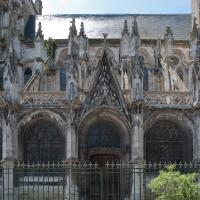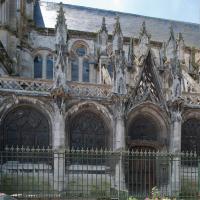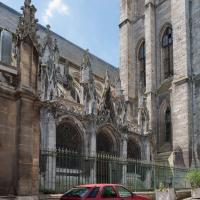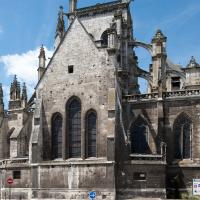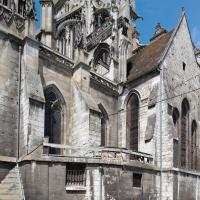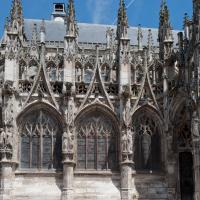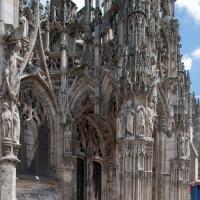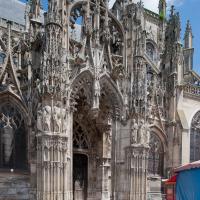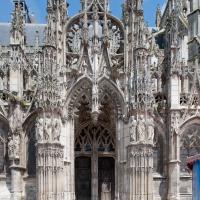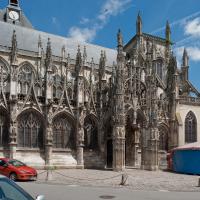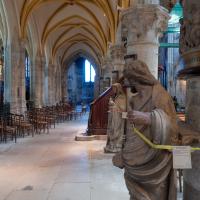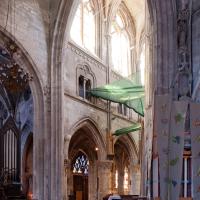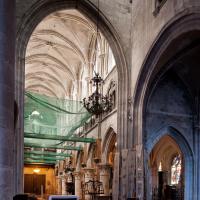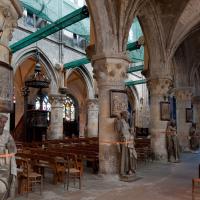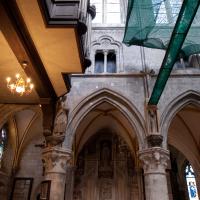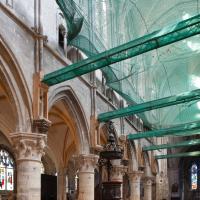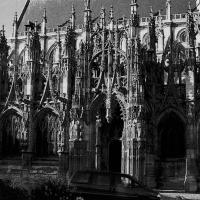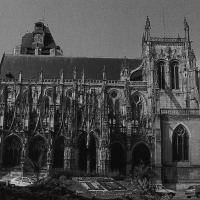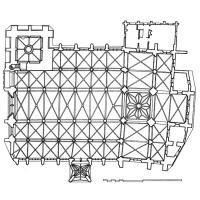Images
Notes
History
In 996 Duke Richard I placed the church of Louviers under the patronage of of the abbey of S-Taurin of Evreux. In the 12th century the town was under the authority of the archbishop of Rouen. The prosperity of Louviers resulted from activities in textile production. The first mention of the church of Notre-Dame dates from 1210, but its transept and chevet belong to the late 12th century: the nave was probably begun in the 1190s. Having suffered badly in the hostilities of the Hundred Years War, Louviers recovered rapidly after 1450. In 1460 the clergy of Notre-Dame of Louviers, intending to enlarge the church, acquired a quarry: Master Jehan Gillat then began work on an additional nave aisle on the north side, continuing then on the south where a magnificent porch provided access toward the city center.
The steeple, constructed in the late 14th century was blown away in a storm in 1704.
The church was heavily restored in 1865
Date
Begun ca. 1197
Plan
A 7-bay nave is flanked by double aisles, the outer one a later addition. From the crossing, surmounted by lantern tower, is generated a 2-bay aisleless transept. The 2-bay chevet is terminated by a flat east end. A massive north-west tower (Tour Challenge, named for the adjacent chapel founded by Guillaume Challenge) was begun in 1414: work was interrupted on account of the hostilities of the Hundred Years War.
Elevation
The chevet, with its triple-lancet east window, has been very extensively reworked and little is know about its original form. The nave has a three-story elevation: the supports are cylindrical columns that recall (distantly) those of Notre-Dame of Paris; at the level of the abacus begin bundles of tripled shafts that mark the bay division. The shafts sit upon prominent corbels with human heads. A closer connection might be drawn with the chevet of Rouen Cathedral and Auffay. Massive figures of the Apostles placed upon corbels above impost level, line the nave -- the arrangement recalls the upper chapel of the Ste-Chapelle in Paris. The middle level is an unusual trilobed triforium, originally opening into the space between the aisle vaults and aisle roof. With the addition of the outer aisles the roofs were reworked and the triforium was glazed. The cornice above the triforium also has trilobed decoration: the vaults of the nave main vessel originally sprang from this level. The clerestory has been reworked from west to east in the 13th century.
Chronology
Work probably began c1180s in the chevet and continued in the nave towards 1200. The crossing tower belongs to the 1230-40s when the nave was probably finished. The northwest tower was begun in 1414 and the outer nave aisles in the later 15th century The church was extensively reworked in the later Middle Ages when additional aisles were added and the crossing tower with its elaborate lierne vault and western crossing piers were rebuilt (early 16th century).
Significance
The early work reveals a community where Rouen Cathedral and Auffay (cyclindrical chevet piers) were key members. The trilobed triforium is quite unusual. The late Gothic reworking brought a kind of dilation or expansion and established a new north-south axis. The extraordinary south porch points to the transept porches of S-Ouen, Rouen and the base of the Tour de Beurre of the Cathedral.
Location
Bibliography
Bottineau-Fuchs, Y., Haute-Normandie Gothique, Paris, 2001, 230-239
Hérold, M., Louviers: église paroissale Notre-Dame, Rouen, 1995
Le Mercier, E., Monographie de l'Église Notre-Dame de Louviers, Évreux, 1906
Régnier, L., "L'église Notre-Dame de Louviers," La Semaine religieuse, March 1903, 3-13
Verdier, F., "L'église paroissiale Notre-Dame de Louviers," Congrès archéologique, 138, 1984, 9-28


